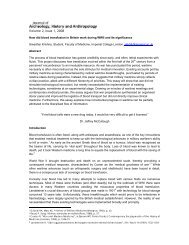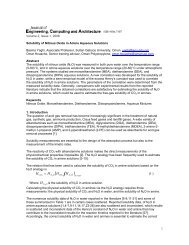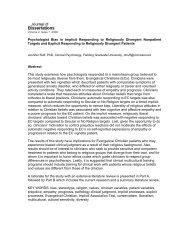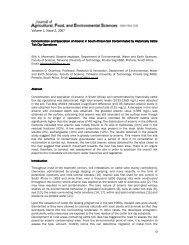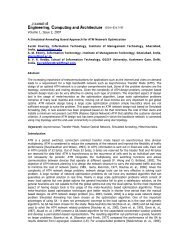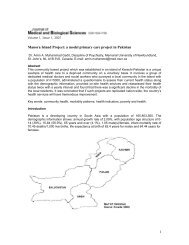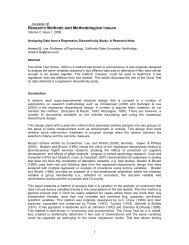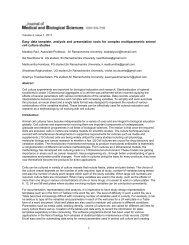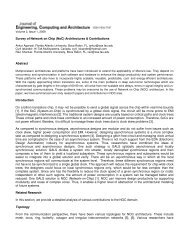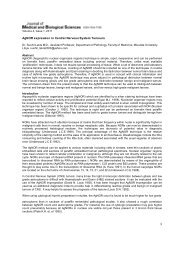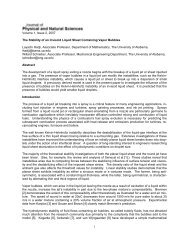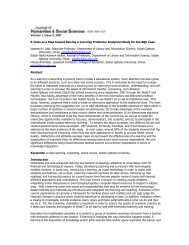The Heaven and Earth Society and the Red Turban Rebellion in ...
The Heaven and Earth Society and the Red Turban Rebellion in ...
The Heaven and Earth Society and the Red Turban Rebellion in ...
Create successful ePaper yourself
Turn your PDF publications into a flip-book with our unique Google optimized e-Paper software.
he had gone to Guangzhou with a large naval force to protect <strong>the</strong> factories. 178 <strong>The</strong> presence of <strong>the</strong> British<br />
naval force along <strong>the</strong> Pearl River impeded seriously <strong>the</strong> river fleet operations of <strong>the</strong> <strong>in</strong>surgents <strong>in</strong> <strong>the</strong> regions.<br />
This was one of <strong>the</strong> reasons, as claimed by some authorities, for <strong>the</strong> sudden collapse of <strong>the</strong> <strong>Red</strong> <strong>Turban</strong>s. 179<br />
In February of 1855 <strong>the</strong> Guangzhou authorities were able to recover almost all <strong>the</strong> Pearl River Delta.<br />
Militia<br />
Lastly, resistances from <strong>the</strong> gentry’s organized militias sent <strong>the</strong> <strong>Red</strong> <strong>Turban</strong> army to death. In face<br />
of <strong>the</strong> failure of <strong>the</strong> regular troops <strong>in</strong> time of crisis, <strong>the</strong> first response of <strong>the</strong> Q<strong>in</strong>g military leadership was to<br />
hire paid fighters, or yong 勇 , to supplement <strong>the</strong> regular forces. 180 <strong>The</strong>re were numerous mercenaries<br />
employed by Q<strong>in</strong>g forces at Guangzhou at <strong>the</strong> beg<strong>in</strong>n<strong>in</strong>g of <strong>the</strong> <strong>Red</strong> <strong>Turban</strong> <strong>Rebellion</strong>, but as <strong>the</strong> war wore<br />
on, <strong>the</strong>re was an acute shortage of government funds, 181 <strong>and</strong> <strong>the</strong> gentry were <strong>in</strong>duced by <strong>the</strong> Governor-<br />
General with <strong>the</strong> promise of honors, titles or even officers to use <strong>the</strong>ir own resources to hire <strong>the</strong>ir clansmen<br />
as mercenaries <strong>and</strong> to organize <strong>the</strong>ir clans <strong>in</strong>to self-f<strong>in</strong>anc<strong>in</strong>g militia units. 182<br />
<strong>The</strong> <strong>Red</strong> <strong>Turban</strong> drive through <strong>the</strong> Pearl River Delta areas <strong>in</strong> <strong>the</strong> 1850s galvanized residents to remobilize<br />
for self-defense. Now, <strong>in</strong> <strong>the</strong> cities <strong>and</strong> <strong>the</strong> larger market town, <strong>the</strong> officials <strong>and</strong> elites resurrected<br />
<strong>the</strong> procedures used <strong>in</strong> sanyuanli 三 元 里 <strong>in</strong> 1841 dur<strong>in</strong>g <strong>the</strong> Opium War—<strong>the</strong> formation of militia or selfdefense<br />
bureaus, <strong>the</strong> recruitment of mercenaries, <strong>and</strong> <strong>the</strong> organization of baojia as a patrol system <strong>and</strong><br />
conscription pool. <strong>The</strong>se rural defense groups, most commonly called “white soldiers” (baib<strong>in</strong>g 白 兵 ) for <strong>the</strong><br />
white cloth <strong>the</strong>y wrapped around <strong>the</strong>ir heads to dist<strong>in</strong>guish <strong>the</strong>mselves from <strong>the</strong> ‘red-turbaned’ rebels, were<br />
usually identified by <strong>the</strong> name of <strong>the</strong> small market town or village that served as <strong>the</strong>ir headquarters,<br />
suggest<strong>in</strong>g that natural, as opposed to adm<strong>in</strong>istrative, units formed <strong>the</strong> basis of organization. 183<br />
<strong>The</strong> most formidable militia complex around <strong>the</strong> Pearl River Delta was organized <strong>in</strong> Shunde county.<br />
Accord<strong>in</strong>g to <strong>the</strong> Shunde County gazetteer, Shunde county was badly hit by <strong>the</strong> <strong>Red</strong> <strong>Turban</strong>s. In addition to<br />
<strong>the</strong> usual village-by-village devastation, <strong>the</strong>re were also ru<strong>in</strong>ous raids executed by <strong>Red</strong> <strong>Turban</strong>s from o<strong>the</strong>r<br />
counties. F<strong>in</strong>ally, when <strong>the</strong> <strong>Red</strong> <strong>Turban</strong>s captured <strong>the</strong> county capital <strong>in</strong> 1854, <strong>the</strong> county magistrate of<br />
Shunde fled, <strong>and</strong> <strong>the</strong> local government dissolved. 184 After <strong>the</strong> downfall of <strong>the</strong> local government, <strong>the</strong> gentry<br />
class <strong>in</strong> Shunde county quickly reasserted itself. It reorganized militia <strong>in</strong> villages <strong>and</strong> <strong>in</strong> a few months, drove<br />
<strong>the</strong> <strong>Red</strong> <strong>Turban</strong>s out of Shunde county. It was reported that 13,000 rebels had been executed <strong>in</strong> <strong>the</strong> course<br />
of suppress<strong>in</strong>g <strong>the</strong> rebels. Subsequently, when <strong>the</strong> order from <strong>the</strong> prov<strong>in</strong>cial governor to form <strong>the</strong> militia<br />
arrived, <strong>the</strong> gentry greatly exp<strong>and</strong>ed <strong>the</strong> scope of <strong>the</strong> local militia to form <strong>the</strong> Shunde county Central Militia<br />
Bureau on May 7, 1855. 185<br />
Ano<strong>the</strong>r powerful militia unit, once called <strong>the</strong> N<strong>in</strong>ety-Six Villages <strong>in</strong> Nanhai county <strong>and</strong> situated<br />
somewhere between Guangzhou <strong>and</strong> Foshan, was formed. <strong>The</strong>y were so well organized <strong>and</strong> efficient that<br />
<strong>the</strong>y not only successfully defended <strong>the</strong>ir villages, but also brought a halt of Chen Kai’s troops who were<br />
178 Stanley Lane-Poole, <strong>The</strong> life of Sir Harry Parkes, K.C.B., G.C.M.G., sometime Her Majesty's m<strong>in</strong>ister to<br />
Ch<strong>in</strong>a <strong>and</strong> Japan., Vol. i. (London, New York: Macmillian <strong>and</strong> co., 1894), 221.<br />
179 Chikashi Hirayama 平 山 周 , Zhong’guo mimi shehuishi 中 國 秘 密 社 會 史 , (Shanghai, 1912), 1935<br />
edition, p.p. 26-27.<br />
180 Broadly speak<strong>in</strong>g, <strong>the</strong> term yong was used to denote any irregular forces of a loyalist character. Thus <strong>the</strong><br />
militia of a tuanlian 團 練 association were sometimes described as tuanyong 團 勇 . But generally yong 勇<br />
referred to forces on a higher level of militarization: men who were entirely detached from <strong>the</strong>ir<br />
communities <strong>and</strong> who depended for <strong>the</strong>ir sustenance upon pay or loot. Some such units were recruited<br />
directly by government officials, such as notorious yong from Chaozhou. See Jian, Quanshi, Vol. 1, 370.<br />
181 Shortage of military funds was ano<strong>the</strong>r reason for <strong>the</strong> prolonged war. <strong>The</strong> f<strong>in</strong>ancial structure of <strong>the</strong> Q<strong>in</strong>g<br />
dynasty was rigid <strong>and</strong> <strong>in</strong>compatible with <strong>the</strong> needs of special circumstances. <strong>The</strong> M<strong>in</strong>istry of F<strong>in</strong>ance could<br />
barely make ends meet even <strong>in</strong> time of peace, <strong>and</strong> <strong>in</strong> wartime <strong>the</strong> central government could only issue<br />
mobilization orders <strong>and</strong> dispatch troops to <strong>the</strong> front, without be<strong>in</strong>g able to give <strong>the</strong>m adequate weapons <strong>and</strong><br />
provisions. <strong>The</strong>se had to be furnished by <strong>the</strong> locality where <strong>the</strong> war occurred. See F.O. 931.1092. A report<br />
regard<strong>in</strong>g military preparation for attack<strong>in</strong>g rebels (1850s).<br />
182 F.O. 253A. 3. 56. Regulations aga<strong>in</strong>st b<strong>and</strong>itry, etc. (1855)<br />
183 Xuxu 徐 续 , L<strong>in</strong>g’nan guj<strong>in</strong>lu 岭 南 古 今 录 (Guangzhou: Guangdong renm<strong>in</strong> chubanshe, 1992), 236-237.<br />
184 Shunde Xianzhi, 1929, 23.5-7.<br />
185 Ibid., 3.1, 16.3, 23.7.<br />
27



